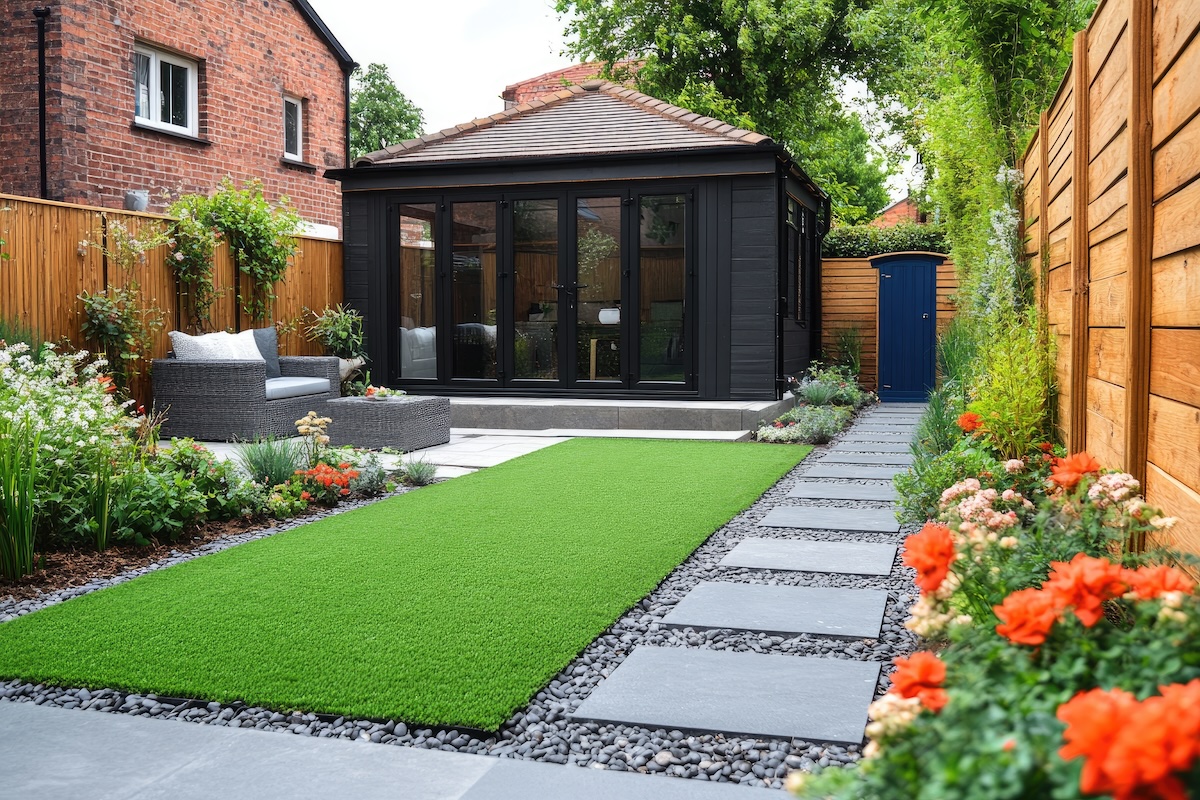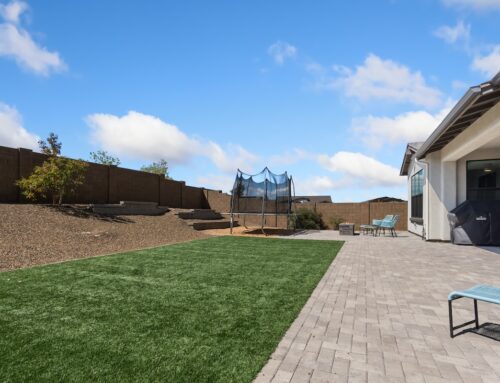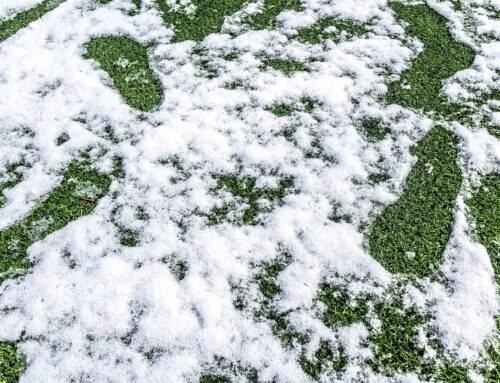Last Updated on December 5, 2024 by ReTurf
Thinking about switching to artificial grass? Synthetic turf can provide potential long-term savings in several ways—not the least of which is cutting out recurring costs tied to maintaining a natural grass lawn. No mowing, no irrigation systems guzzling water, no fertilizers—and no repeated expenses for reseeding or weed control.
And let’s not forget about the time you’ll save. If you’ve ever spent a Saturday wrangling a lawnmower, patching up bare spots, or troubleshooting a sprinkler system that suddenly decided to water the driveway instead of the yard, you know how much effort a traditional lawn can take.
Synthetic grass eliminates all that, giving you more time to relax or focus on other projects without feeling like your weekend got swallowed up by yard work.

These factors can make synthetic grass an appealing choice for anyone looking to reduce ongoing upkeep costs. Of course, the upfront investment can sometimes be substantial, so it’s worth carefully weighing the potential savings and convenience against your specific needs, budget, and the goals you have for your outdoor space.
All that said, if you’re interested in making the most of your budget, there are a variety of strategies to save money installing artificial turf without compromising the outcome of your project. Here are some practical, budget-conscious options to consider:
Ways to Save Money on Artificial Turf Installation
Plan Thoroughly Before You Start

Jumping into a project without a clear plan is one of the quickest ways to run up unnecessary costs. From unexpected material expenses to avoidable mistakes during installation, poor planning can quickly turn what should be a cost-saving upgrade into an over-budget headache.
Installing synthetic grass is no exception. Taking the time to map out every detail of your project can save you significant time, effort, and money.
Tip: If creating a detailed plan feels overwhelming, ReTURF’s team can help. They offer professional guidance customized for your project’s specific needs. From selecting the right turf to providing technical drawings and seaming diagrams, their support can simplify the planning and execution process.
Rent Equipment Instead of Buying
Installing artificial turf often requires specialized tools, such as turf cutters, compactors, or seaming tools. If you are installing the turf yourself, rather than purchasing these items outright—which can quickly inflate your project costs—look into renting them from a local hardware store or rental service. This allows you to use the equipment you need without larger, longer-term expenses.
Avoid Overspending with Precise Measurements
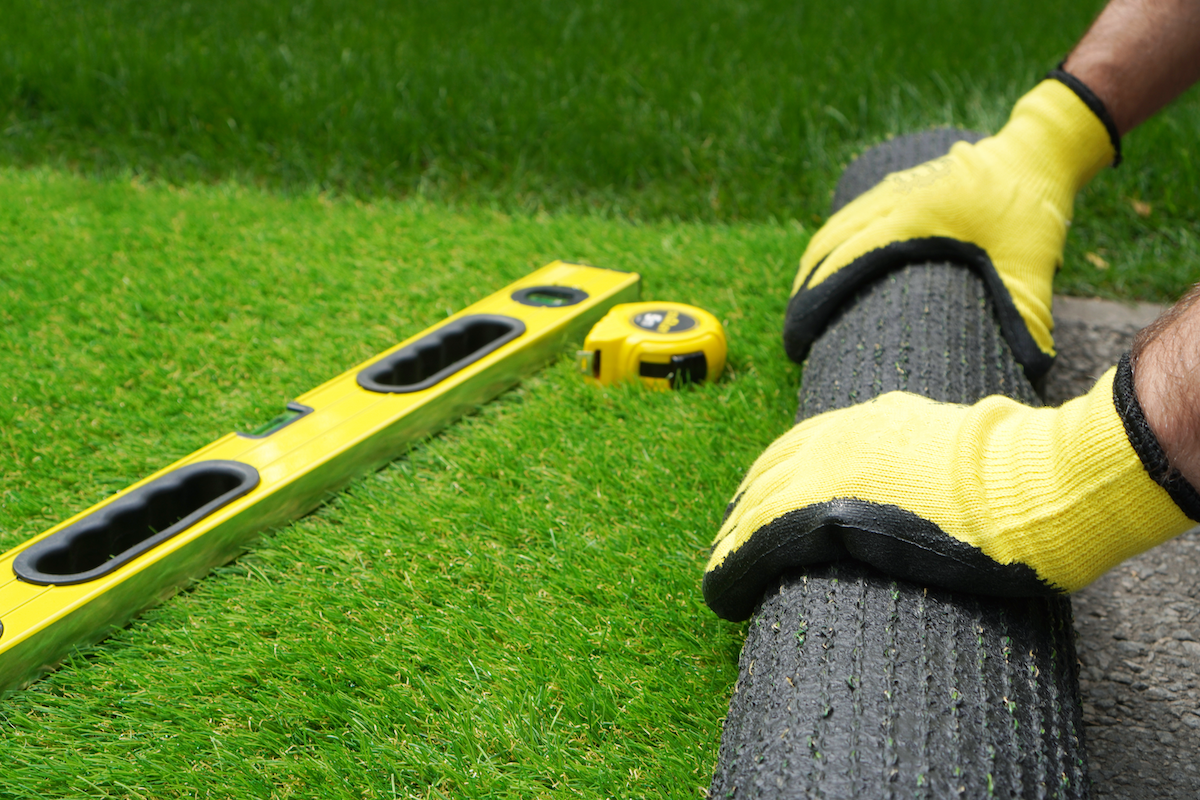
Accurate measurements are key to saving money on any landscaping project. Ordering too much turf or buying excess supplies can inflate your costs unnecessarily. Take the time to measure your property carefully before placing your order. Double-check measurements for accuracy—it’s a small step that can prevent expensive mistakes.
Tip: This isn’t the time to eyeball it—precise measurements help you avoid overspending on excess turf or scrambling to match a new batch later if you underestimate.
Rushing through this stage might seem tempting, especially for DIYers eager to start the project. But detailed measurements will save you time, money, and frustration during the installation process.
Key Tips for More Accurate Measurements
- Use the Right Tools: Invest in a quality measuring tape, laser measure, or other precise tools to ensure accuracy. For larger areas, tools like a wheel measure can save time while providing consistent results.
- Divide Irregular Spaces: For oddly shaped areas, break them into smaller geometric sections (rectangles, triangles, or circles) and calculate the area for each. Add the totals together for a precise measurement of the entire space.
- Account for Overlap and Edging: Include a buffer in your calculations to account for necessary overlaps at seams and trimming along edges. Typically, adding 5-10% to your total area is sufficient.
- Double-Check Your Work: Measure each section twice and verify your calculations before finalizing your order. A small mistake on paper can translate to hundreds of dollars in unnecessary costs.
- Consider Professional Assistance: For complex layouts or larger projects, consulting a professional or requesting help from a turf supplier like ReTURF can provide peace of mind and ensure accurate material estimates.
Opt for Lower-Pile Turf
The pile of artificial turf refers to the height of the grass blades. It’s measured from the base of the turf to the tip of the fibers. High-pile turf has longer blades, often designed to look like lush, natural grass, which is great for areas where appearance is a top priority, like a front yard or a decorative garden space. On the other hand, low-pile turf has shorter blades, which can be a better fit for spaces where function matters more than looks.
High-pile artificial grass, which mimics the height and feel of natural grass, tends to be more expensive.

If your project doesn’t necessarily require a high-pile aesthetic, such as for a pet area, putting green, or utility space, you can save money by selecting lower-pile options. These can be just as durable—or even more durable—but come at a lower cost.
Tip: High-pile turf looks luxurious but comes with an appropriately higher price tag because of the extra material involved. If your project doesn’t need that lush, natural look, lower-pile options are just as durable and practical while costing less. They also tend to be easier to maintain, as shorter blades collect less debris and require less brushing to keep them upright.
Consider Used Turf Options

Many people don’t realize that used artificial turf is available in the first place—and it can save you a significant amount of money. Opting for professionally reconditioned turf collected from sports fields and stadiums can reduce costs by as much as 90% compared to purchasing new artificial turf.
For projects where 100% perfect aesthetics aren’t the primary concern, used turf can be a viable, affordable alternative with longer-lasting durability.
That said, for projects where looks are a primary concern, unmarked reclaimed or recycled turf may still be able to meet your needs without breaking the bank.
Cut Freight Costs with Lightweight Shipping
A commonly underestimated expense in artificial turf projects is the cost of shipping, especially for reclaimed turf. One significant factor driving up freight costs is the weight of the infill material, typically added to mimic the density and texture of soil.
Infill, often composed of sand, rubber, or a combination of both, is exceptionally heavy, which can dramatically increase transportation fees.
Companies like ReTURF solve this issue by removing infill from reclaimed turf before shipping, making it much lighter and less expensive to transport.
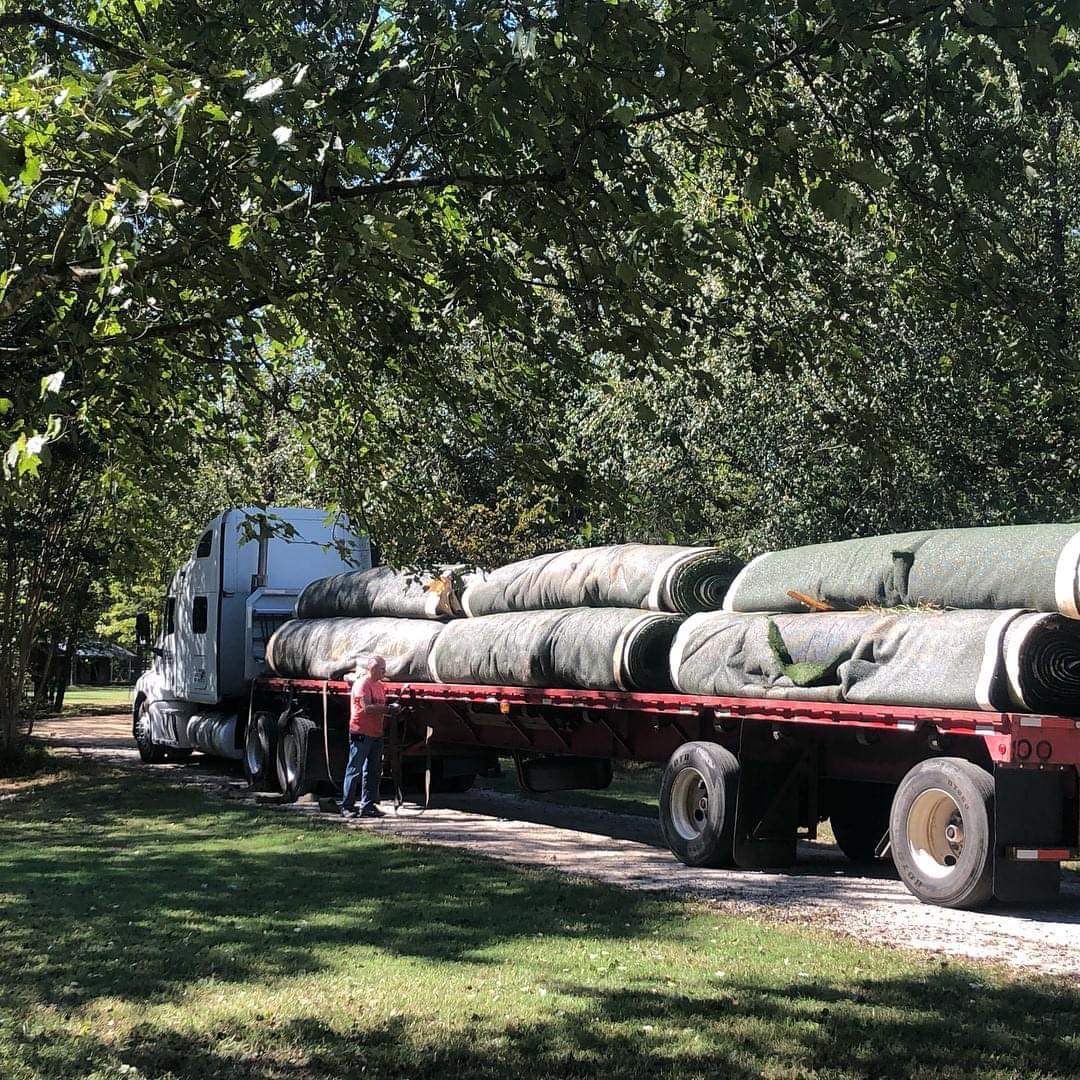
Another benefit of infill removal is that it often softens the turf’s fibers, giving the grass a cushier feel and a more natural appearance. Unlike brand-new turf, which can sometimes require extensive brushing and fresh infill to look realistic, used turf with pre-softened fibers will often provide a more natural look straight out of the box.
This pre-softened texture can be a major advantage compared to brand-new turf, which often arrives stiff and requires additional brushing and the application of fresh infill to achieve the most realistic looking artificial turf.
Leverage Rebates and Incentives
Check with local government programs or water utility companies to see if they offer rebates or incentives for switching to artificial turf.
Certain municipalities encourage water conservation by subsidizing turf installation, making this a great way to offset the cost. Some programs even cover a percentage of the installation cost or provide grants for eco-friendly landscaping projects.
Purchase Remnants or Off-Cuts

Suppliers often have leftover pieces of artificial turf from larger projects, known as remnants or off-cuts. These are typically sold at a steep discount, and are often in brand new condition, which can make them perfect for smaller projects like patios, pet areas, or walkways.
While availability and sizes may vary, new artificial remnants can be an excellent way to save on material costs.
Reuse Existing Base Materials
If you’re upgrading or replacing an existing lawn, driveway, patio, or other surface, take the time to evaluate the condition of the materials already in place beneath the structure. Often, foundational components such as compacted gravel, crushed stone, or sand remain in remarkably good shape despite years of use.
Instead of discarding these materials, which can be both wasteful and costly to replace, consider incorporating them into your new project as a repurposed base layer.
This approach not only minimizes the expense associated with purchasing fresh base materials but also reduces waste sent to landfills and the environmental footprint of your project. Of course, properly inspecting and reconditioning these materials where necessary is important to make sure they will continue to provide a sturdy, stable foundation for the long-term success of your installation.
Minimize Excess Features
While extras like decorative edging, or intricate designs can enhance the look of your artificial turf, they also drive up costs. Focus on functionality and opt for standard materials to stay within your budget. You can always add upgrades later as funds allow.
Partner with Neighbors for Bulk Savings

If others in your neighborhood are also considering artificial turf, join forces to negotiate a bulk discount. Many suppliers offer lower prices for larger orders, so pooling resources with neighbors or friends can help everyone save money. Additionally, sharing shipping or delivery fees can further reduce costs.
Analyze Installation Costs: DIY vs. Professional
Many assume that doing the installation themselves will save money, but that’s not always the case. Mistakes made during a DIY installation—such as improper grading, uneven seams, or poorly installed drainage—can lead to costly fixes.
On the flip side, hiring a professional comes with higher upfront costs but often includes warranties and makes sure the job is done right the first time. Carefully consider the complexity of your project before deciding whether to DIY or go pro.

Just how hard is it to install artificial turf yourself? Well, for smaller areas and more straightforward projects, a DIY approach might make sense. For larger or more elaborate/intricate installations, professional expertise can prevent a lot of errors that can become costly down the line.
That said, if you’re confident in your abilities, consider installing the turf yourself. Some suppliers offer detailed guides and DIY tutorials, making it easier for homeowners to tackle the process. However, you’ll want to make sure you have the right tools and understand all of the steps involved, as mistakes at this point can be expensive to fix later.
Here are some ways that DIY installation of artificial turf can sometimes end up costing more than hiring professionals.
Mistakes Can Be Expensive to Fix
Installing artificial grass is a precise process that requires preparation, precise alignment, and proper securing of the material.
Common DIY mistakes include improper base installation, uneven grading, poorly executed seams, or inadequate drainage systems.

These errors can lead to issues like wrinkles, water pooling, or turf shifting over time—problems that often require professional intervention to correct. Fixing these mistakes can cost as much, or more, than the original installation.
Equipment Rental Costs Add Up
While renting equipment like turf cutters, compactors, and seaming tools can save money compared to purchasing them, the costs can still be significant if the project takes longer than expected. Delays or unforeseen complications can mean additional days of rental fees, driving up the overall expense.
Material Waste Due to Inexperience
Accurate cutting and placement are essential to minimizing material waste. DIYers often over-order to compensate for potential mistakes or end up with unusable scraps due to incorrect measurements or cuts. Professionals typically know how to optimize material usage, reducing waste and saving money.
Time Costs & Labor Intensity
Installing artificial turf is labor-intensive, involving tasks like excavating the area, leveling and compacting the base, and securing the turf.
DIYers often underestimate the amount of time and physical effort required. If you have to take time off work or hire additional help partway through the process, those costs can quickly add up.
Specialized Techniques Are Often Required
Professionals use specialized techniques, like creating invisible seams or setting up proper drainage systems, that can be hard for a DIYer to replicate without training.
Skipping these steps or doing them improperly can reduce the lifespan and appearance of the turf, ultimately costing more in repairs or replacements.
When DIY Might Make Sense
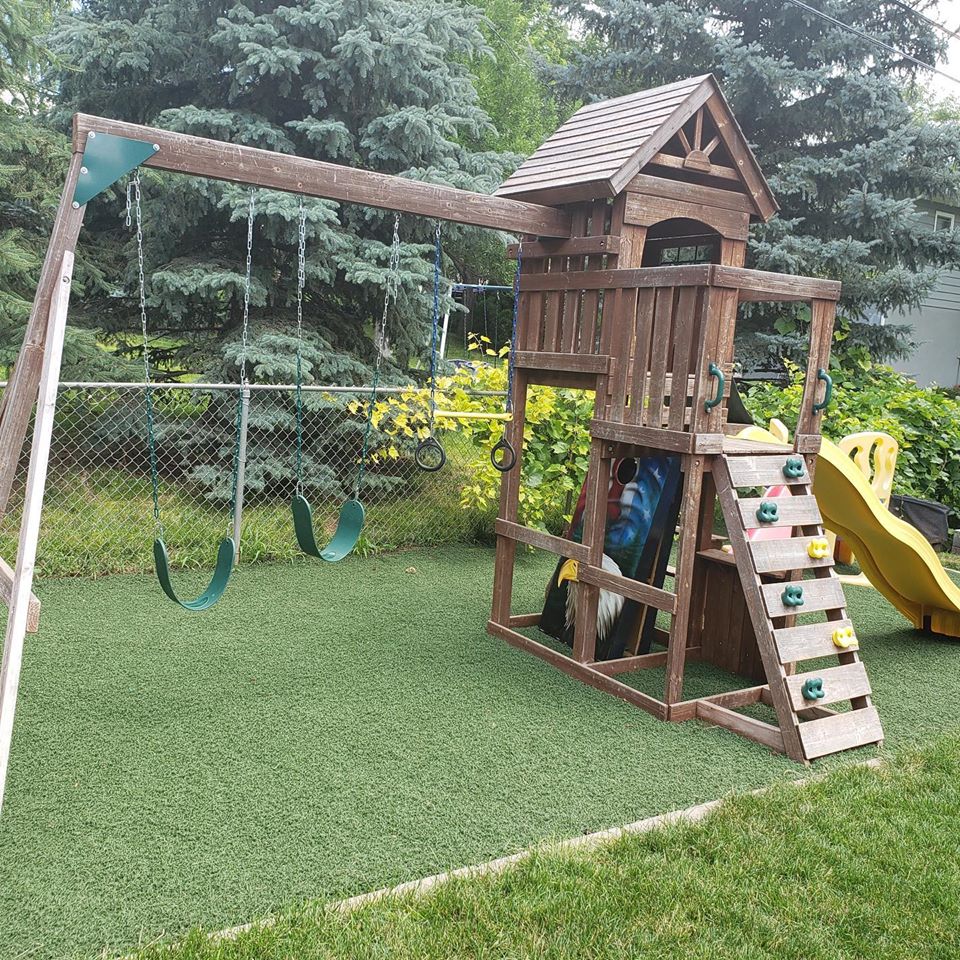
DIY can be a cost-effective option for smaller projects, such as pet areas, patios, or decorative patches, where mistakes are less costly to fix and the stakes are lower. However, for larger or more complex installations, the risks and potential hidden costs of DIY often outweigh the initial savings.
If you’re considering a DIY approach, carefully evaluate your skills, time, and the complexity of your project. In many cases, hiring a professional ensures a more durable, polished result—and can save you money in the long run by avoiding costly errors.
Long-Term Savings Add Up
Synthetic grass offers undeniable financial advantages over time. Once installed, it eliminates recurring expenses like mowing, fertilizing, reseeding, and—most significantly—watering. For property owners dealing with rising water costs, this can translate into substantial savings. While the upfront investment may require careful budgeting, the financial benefit is hard to discount—no pun intended.
Of course, the cost-saving potential doesn’t end there. By incorporating strategies such as choosing used turf, cutting down on shipping costs, and planning your project meticulously, you can make the entire process more budget-friendly.
Artificial turf may not be the perfect fit for every project—but for anyone seeking a lower-maintenance, cost-effective landscaping solution, it’s certainly worth considering. If you’re managing a residential property, working as a contractor, or designing a public space, these tactics can help make artificial turf an approachable and financially viable choice.

